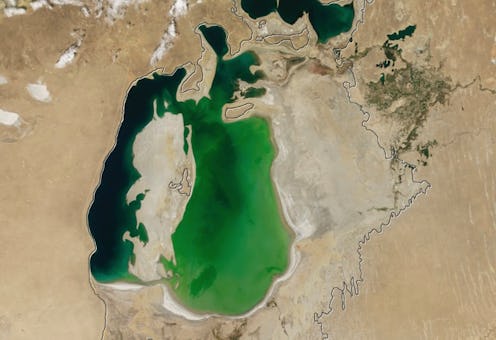News
This Lake Has Disappeared, Year By Year

Have you heard of the Aral Sea? It's OK if you haven't — it's not always easy to keep up on the international ecological news — but what's been going on there in the last few decades has been dramatic, and it really shows. It was once the fourth-largest lake in the entire world, nestled between southern Kazakhstan and northern Uzbekistan, but now, no longer — The Aral Sea is bone-dry, as NASA photos show, and it's had a devastating impact on the communities that once depended on it.
Why did this happen, exactly? According to The Independent, it's largely thanks to Soviet-era irrigation projects which diverted water fed into the lake by the Syr Darya and Amu Darya rivers. Until its collapse in the late '80s and early '90s, both Kazakhstan and Uzbekistan were Soviet satellites, and they wanted to irrigate swaths of the unforgiving, arid desert into farmable land, mainly for cotton production.
But as time marched onward, the deviation of the rivers' water away from the Aral Sea spurred the lake's shoreline to recede farther and farther in. The photos NASA released recently only show the sea dating back to 2000, at which point it was already a hollow shell of its original size (the black line surrounding the lake marks its approximated full size back in 1960).
2001
As you can see pretty clearly, the Aral Sea was already in dire straits in 2001, with the main body dried up around the edges of the waterline, and barely connecting to the smaller, narrower part of the lake on the left-hand side. But it gets much, much worse.
2003
Just two years later, and the withering size of the lake is that much more apparent — while the western branch appears relatively unchanged, even more of the Aral Sea's once-submerged basin is exposed, baking under the hot Kazahk/Uzbek sun.
2005
If you do an image search for "healthy lake," this isn't what you'll find.
By 2005, the Aral Sea's decline reached pronounced levels — as you can see, the main basin has dried up to the extent that the water is shallower and even narrower than before. It was at this point, according to The Independent, that Kazakh authorities constructed a dam to try to salvage the northwestern section of the lake, but in doing so, they effectively doomed the larger, southeastern section.
2010
How the mighty have fallen. While the effort to salvage the northwestern portion of the Aral Sea apparently saw modest success over the next five years, the impact on the rest of the lake was dismal. At this point, the water was shallow and increasingly fleeting, and according to NASA, the drying-out process had consequences for surrounding farmers and communities beyond just quantity — the saline content of the remaining water increased, and what was left was increasingly tainted with pesticides and fertilizer.
In short, the Aral Sea was rapidly dying. And its main basin, sadly, wouldn't last to see another five years.
2014
There you have it. Pretty awful, right? It may have taken its time — you don't see a lake that size dry up overnight, after all — but it's basically all gone now, save for the scant portions that were salvaged through the dam project. From the fourth-largest lake in the world to virtually nothing in about 50 years, the heavy cost of trying to transform a desert. Those kinds of irrigation projects can be problematic when dry seasons start to hit, as anybody in Southern California knows pretty well. This is shocking and depressing.
And, perhaps more than anything, it's a dire state of affairs for the people who relied on the Aral Sea — according to NASA, the loss of the lake has made for hotter summers, colder winters, and salt-heavy dust blowing off the basin has degraded the soil in the surrounding lands. In simplest terms, people need water to survive. And thanks to decades of devil-may-care mismanagement and oversight, a whole lot of it has gone up in smoke.
Images: NASA (6)